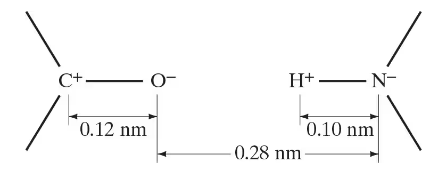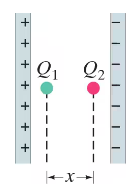 Back
BackProblem 11
Two positive point charges are a fixed distance apart. The sum of their charges is Qₜ. What charge must each have in order to
(a) maximize the electric force between them, and
(b) minimize it?
Problem 38
Draw, approximately, the electric field lines emanating from a uniformly charged straight wire whose length ℓ is not great. The spacing between lines near the wire should be much less than ℓ. [Hint: Also consider points very far from the wire up to 4ℓ \.]
Problem 40
You are given two unknown point charges, Q₁ and Q₂. At a point on the line joining them, one-third of the way from Q₁ to Q₂, the electric field is zero (Fig. 21–64). What is the ratio Q₁/Q₂?
Problem 55
An electron moving to the right at 7.5 x 10⁵ m/s enters a uniform electric field parallel to its direction of motion. If the electron is to be brought to rest in the space of 5.0 cm,
(a) what direction is required for the electric field, and
(b) what is the strength of the field?
Problem 69
Estimate the net force between the CO group and the HN group shown in Fig. 21–72. The C and O have charges ± 0.40e, and the H and N have charges ±0.20e, where e = 1.6 x 10⁻¹⁹ C. [Hint: Do not include the “internal” forces between C and O, or between H and N.]
Problem 76
Two point charges, Q₁ = ― 6.7 μC and Q₂ = 2.6 μC, are located between two oppositely charged parallel plates, as shown in Fig. 21–74. The two charges are separated by a distance of 𝓍 = 0.47 m. Assume that the electric field produced by the charged plates is uniform and equal to E = 53,000 N/C . Calculate the net electrostatic force on Q₁ and give its direction.
Problem 89
Draw, approximately, the electric field lines about two point charges, +Q and -3Q, which are a distance ℓ apart.



